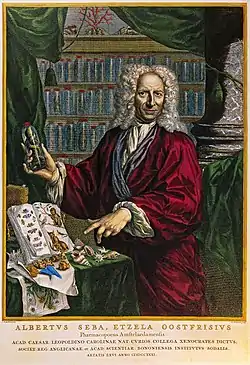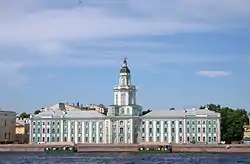Albertus Seba
Albertus Seba (May 12, 1665, Etzel near Friedeburg – May 2, 1736, Amsterdam) was a Dutch pharmacist, zoologist and collector. Seba accumulated one of the largest cabinets of curiosities in the Netherlands during his time. He sold one of his cabinets in 1717 to Peter the Great of Russia. His later collections were auctioned after his death. He published descriptions of his collections in the work Locupletissimi rerum naturalium thesauri accurata descriptio. His early work on taxonomy and natural history influenced Linnaeus.

Career
Born in Etzel, Seba moved to Amsterdam as an apprentice and, around 1700, opened a pharmacy near the harbour. Seba asked sailors and ship surgeons to bring exotic plants and animal products he could use for preparing drugs. Seba also started to collect snakes, birds, insects, shells and lizards in his house.
From 1711 he delivered drugs to the Russian court in Saint Petersburg and sometimes accepted fresh ginger as payment. Seba promoted his collection with the head-physician to Peter the Great, Robert Erskine (1674–1719), and in early 1716 Peter the Great bought the complete collection. In the following several years, Seba managed to develop another collection of natural specimens, which grew more extensive than the first.
With Seba as an intermediate, Frederik Ruysch, a well-known Amsterdam physician and anatomist, also sold his collection to the tsar. Both collections formed the core of the Kunstkammer, the first Russian public museum founded by Peter the Great in 1712.[1] Later, in 1728, when a special museum building was designed and built, both collections, along with many other exhibits, were displayed there.

In October 1728 Seba had become a Fellow of the Royal Society. In 1734, he had published a Thesaurus of animal specimens with beautiful engravings. The full name of the Thesaurus is, with a dual Latin–Dutch title, Locupletissimi rerum naturalium thesauri accurata descriptio – Naaukeurige beschryving van het schatryke kabinet der voornaamste seldzaamheden der natuur (Accurate description of the very rich thesaurus of the principal and rarest natural objects). The last two of the four volumes were published after his death (1759 and 1765). Today, the original 446-plate volume is on permanent exhibit at the Koninklijke Bibliotheek in The Hague, Netherlands. Recently, a complete example of the Thesaurus sold for US$460,000 at an auction. In 2001, Taschen Books published a reprint of the Thesaurus, with a second printing in 2006.[2]
In 1735 Carl Linnaeus visited Seba twice. Linnaeus found Seba's collection to be useful for the classification system which Linnaeus was developing, and Linnaeus used many of Seba's specimens as holotypes for original descriptions of species.[3] Seba's inclusion of fantastic beasts such as the hydra influenced Linnaeus to include the "Paradoxa," species which may exist but which have not been found, in his Systema Naturae.[4]
Seba himself did not use Linnaeus' taxonomy, as it was published only a year before his death. However, he did organize his Thesaurus by physical similarities, leading to some similarities with Linnaeus' larger project.[2]
In 1752, several years after Seba's death, his second collection went on auction in Amsterdam. Several objects were purchased by the Petersburg Academy of Sciences.
Taxa named in honor of Seba
Seba is commemorated in the scientific names of two species and one subspecies of snakes: Ninia sebae, Python sebae, and Oxyrhopus petola sebae.[3]
Gallery
 Frontispiece of the Thesaurus by Frederik Ruysch (Thesaurus animalium primus) by C.Huybrechts (1710)
Frontispiece of the Thesaurus by Frederik Ruysch (Thesaurus animalium primus) by C.Huybrechts (1710) Engraving depicting different views of the hedgehog in the Thesaurus
Engraving depicting different views of the hedgehog in the Thesaurus The Hamburg Hydra, from the Thesaurus (1734)
The Hamburg Hydra, from the Thesaurus (1734)
References
- "Specimens from the Second Collection of Albertus Seba in Poland: the Natural History Cabinet of Anna Jabonowska (1728-1800)" (PDF). Bibliotheca Herpetologica. 6 (2): 16–20. 2006.
- Cabinet of natural curiosities = Das Naturalienkabinett = Le cabinet des curiosités naturelles : Locupletissimi rerum naturalium thesauri, 1734-1765. Willmann, Rainer, 1950-, Rust, Jes, 1963-, Wissemann, Volker., Koninklijke Bibliotheek (Netherlands). Taschen. 2011. ISBN 9783836515832. OCLC 286524743.CS1 maint: others (link)
- Beolens, Bo; Watkins, Michael; Grayson, Michael (2011). The Eponym Dictionary of Reptiles. Baltimore: Johns Hopkins University Press. xiii + 296 pp. ISBN 978-1-4214-0135-5. ("Seba", p. 240).
- Flora illustrata : great works from the LuEsther T. Mertz Library of the New York Botanical Garden. Fraser, Susan M.,, Sellers, Vanessa Bezemer. 2014. ISBN 9780300196627. OCLC 875644465.CS1 maint: others (link)
Further reading
- Driessen, J. (1996) Tsaar Peter de Grote en zijn Amsterdamse vrienden.
- Driessen-Van het Reve, J.J. (2006) De Kunstkamera van Peter de Grote. De Hollandse inbreng, gereconstrueerd uit brieven van Albert Seba en Johann Daniel Schumacher uit de jaren 1711–1752.
- Engel, Hendrik, 'The Life of Albert Seba', Svenska Linné-sällskapets årsskrift, vol. 20 (1937), pp. 75–100.
External links
| Wikimedia Commons has media related to Albertus Seba. |
- Holthuis, L.B. (1969) Albertus Seba's „Locupletissimi rerum naturalium thesauri...." (1734–1765) and the „Planches de Seba" (1827–1831), Zoologische Mededelingen, Vol. 43, pp. 239–252 PDF
- Locupletissimi rerum naturalium thesauri (All volumes scanned at the Biodiversity Heritage Library)
- Volume 1, Botanicus
- Volume 1, Göttinger Digitalisierungszentrum
- Volume 2, Internet Archive
- Volume 3, Digital Library at Gdańsk University of Technology
- Volume 4, Göttinger Digitalisierungszentrum; Gallica
- Cabinet of Natural Curiosities, Catalogue entry for Seba's Cabinet of Natural Curiosities
- Cabinet of curiosities Web page of the Koninklijke Bibliotheek on the Thesaurus exhibition
- Review of thesauri by Claudia Stein, Medical History
- A Cabinet of Natural Curiosities scanned images from Locupletissimi rerum naturalium thesauri. Botanicus.
- Sale and dispersal of the Seba collection